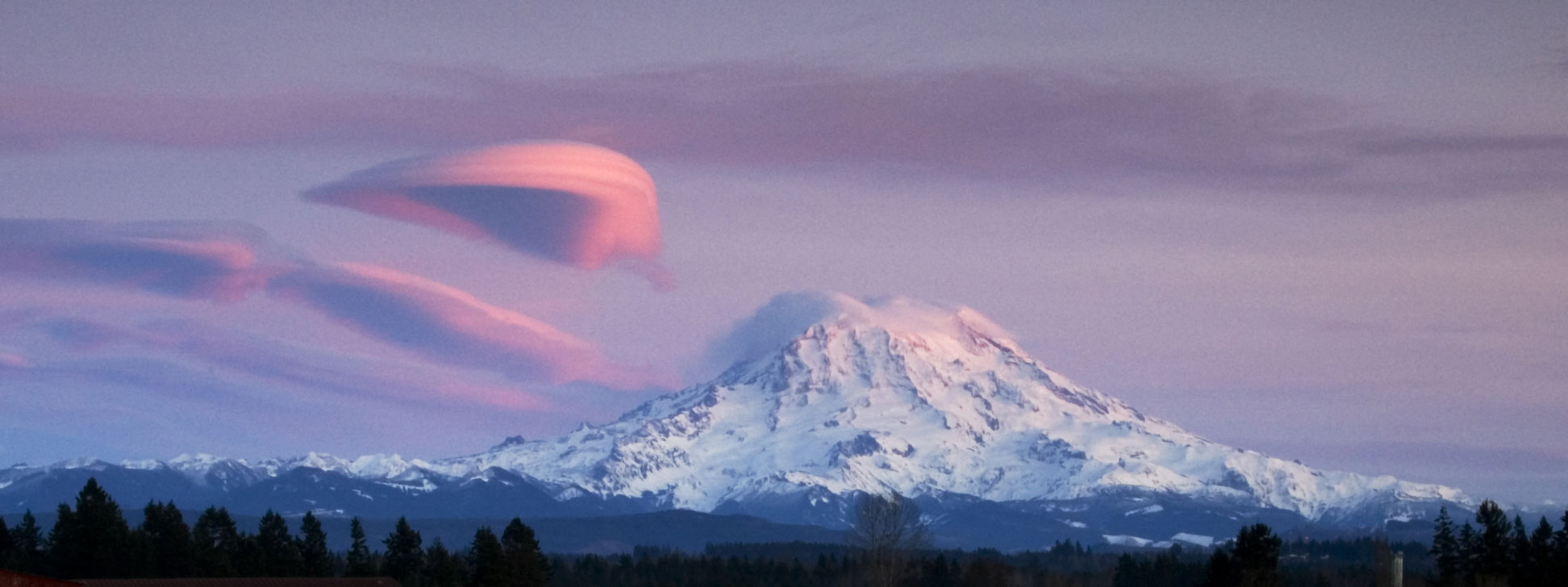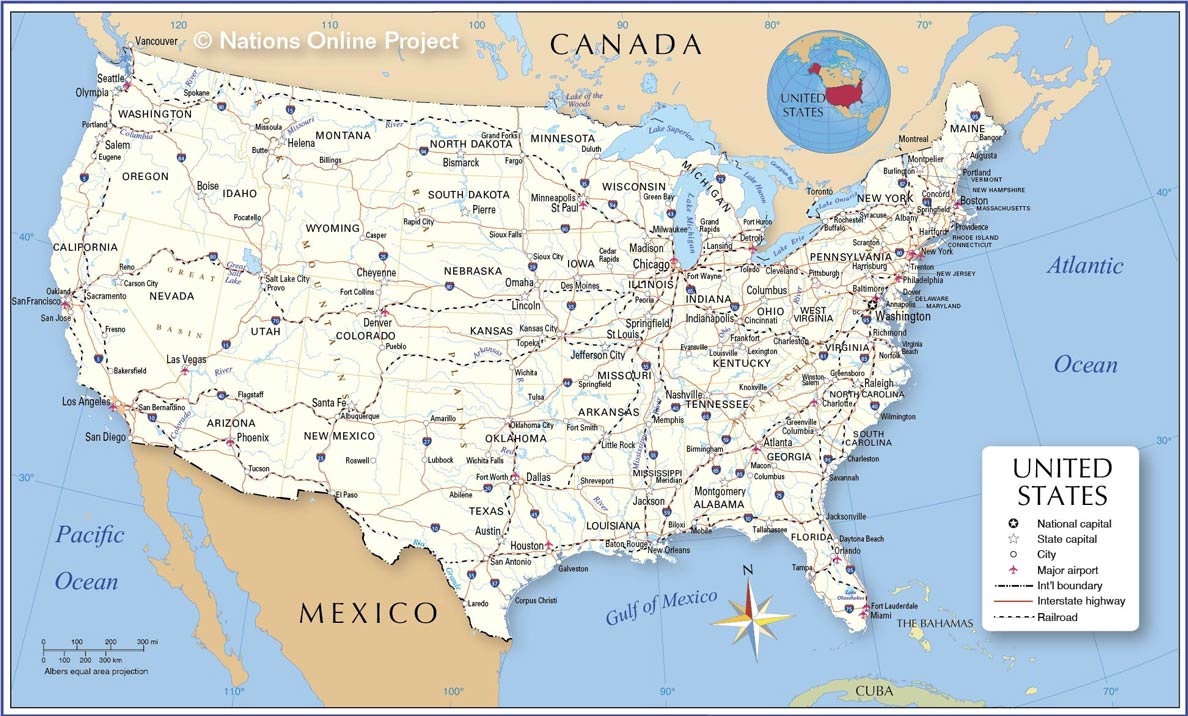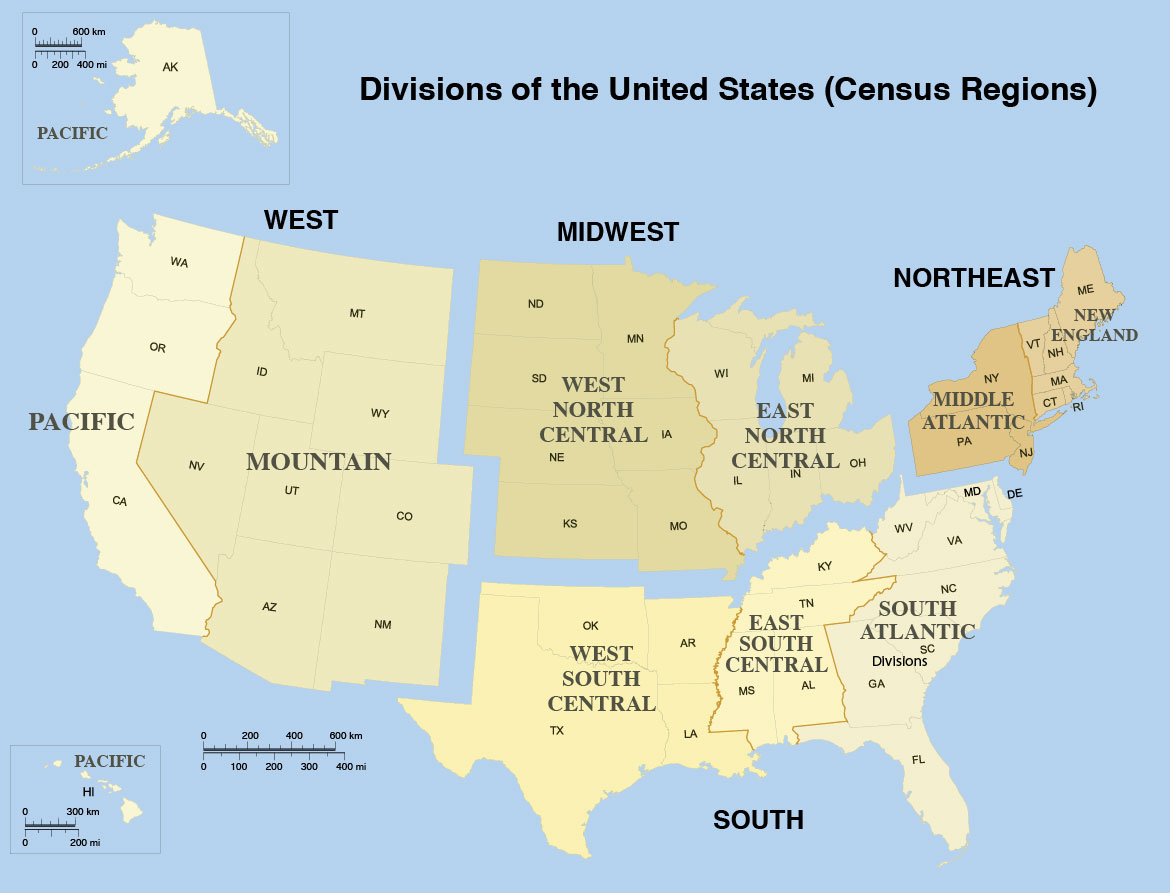| No. |
|
State |
km² |
sq mi |
Census Region |
Notes |
| 30 |
 |
Alabama |
135,767 |
52,420 |
East South Central |
The "Heart of Dixie" is the largest state in the East South Central region. Alabama is the 30th largest state in the United States and offers a diverse topography that ranges from the Appalachian Mountains to the beaches of the Gulf Coast. |
| 1 |
 |
Alaska |
1,723,336 |
665,384 |
Pacific |
Alaska is the largest state in the US; it is not bordered by any other US state. "The Last Frontier" is about 3 times as big as France and about 2.5 times the size of Texas; it is also the least densely populated US state. |
| 6 |
 |
Arizona |
295,233 |
113,990 |
Mountain |
Home to the Grand Canyon. Arizona is about three times the size of South Korea. |
| 29 |
 |
Arkansas |
137,730 |
53,178 |
West South Central |
By comparison, Arkansas is slightly larger than Greece. |
| 3 |
 |
California |
423,968 |
163,695 |
Pacific |
Largest state in the Pacific region on the US mainland and one of three states on the US mainland with a coastline on the Pacific Ocean. California is five times the size of Austria. |
| 8 |
 |
Colorado |
269,602 |
104,094 |
Mountain |
One of the two states that have straight borders that appear to form a rectangle. Colorado is about the size of New Zealand. |
| 48 |
 |
Connecticut |
14,356 |
5,543 |
New England |
One of the six New England states, but nine times smaller than England. |
| 49 |
 |
Delaware |
6,446 |
2,489 |
South Atlantic |
One of the original thirteen states. |
| 22 |
 |
Florida |
170,312 |
65,758 |
South Atlantic |
Largest state in the South Atlantic region of the USA. Florida is about one-third the size of Spain. |
| 24 |
 |
Georgia |
153,910 |
59,425 |
South Atlantic |
One of the original thirteen states. |
| 43 |
 |
Hawaii |
28,313 |
10,932 |
Pacific |
The only US state located on an archipelago. |
| 14 |
 |
Idaho |
216,443 |
83,569 |
Mountain |
By comparison, Idaho is slightly smaller than Great Britain (island). |
| 25 |
 |
Illinois |
149,994 |
57,913 |
East North Central |
By comparison, Illinois is about half the size of Italy. |
| 38 |
 |
Indiana |
94,327 |
36,420 |
East North Central |
Indiana is about the size of Hungary. |
| 26 |
 |
Iowa |
145,744 |
56,272 |
West North Central |
By comparison, Iowa is about twice the size of Ireland. |
| 15 |
 |
Kansas |
213,099 |
82,278 |
West North Central |
The size of Kansas is defined by longitude and latitude, with only the northeast corner cut off by the Missouri River. |
| 37 |
 |
Kentucky |
104,656 |
40,408 |
East South Central |
The Bluegrass State is about one-third the size of Poland and would fit almost seven times into Texas. |
| 31 |
 |
Louisiana |
135,658 |
52,378 |
West South Central |
The Pelican State is somewhat larger than Greece, or about half the size of Colorado. |
| 39 |
 |
Maine |
91,634 |
35,380 |
New England |
Largest state in New England. About twice the size of Estonia. |
| 42 |
 |
Maryland |
32,131 |
12,406 |
South Atlantic |
Maryland is located in the north of the South-Atlantic region of the United States; it is known for its diverse geography, including the Chesapeake Bay, the Appalachian Mountains and its coastal plains. Maryland is slightly larger than Belgium; about 26% of its area is covered by water.
|
| 44 |
 |
Massachusetts |
27,335 |
10,554 |
New England |
The Commonwealth of Massachusetts is somewhat smaller than Belgium and the most populous state in the New England region.
|
| 11 |
 |
Michigan |
250,485 |
96,713 |
East North Central |
Michigan is split into two distinct landmasses, the Upper Peninsula (UP) and the Lower Peninsula (LP), connected by the Mackinac Bridge. It is the largest state in East North Central; however, 40,175 sq mi (104,052 sq km), about 41.5% of Michigan's total area, is covered by water.
|
| 12 |
 |
Minnesota |
225,163 |
86,936 |
West North Central |
The 'Land of 10,000 Lakes' is the largest state in the West North Central region of the United States, and it shares a border with Canada to the north.
|
| 32 |
 |
Mississippi |
125,438 |
48,432 |
East South Central |
The US state of Mississippi was named after the Mississippi River, the second-longest river in the US. |
| 21 |
 |
Missouri |
180,540 |
69,707 |
West North Central |
Missouri was named for the Missouri River, the longest river in the United States. |
| 4 |
 |
Montana |
380,831 |
147,040 |
Mountain |
Montana is the largest state in the Mountain Region. Montana is slightly larger than Germany. |
| 16 |
 |
Nebraska |
200,330 |
77,348 |
West North Central |
Nebraska is located in the middle of the United States, west of the Missouri River, and is about the size of Kyrgyzstan. |
| 7 |
 |
Nevada |
286,380 |
110,572 |
Mountain |
Nevada, the Battle Born State, is about the size of Ecuador and would fit almost 2.5 times within Texas. |
| 46 |
 |
New Hampshire |
24,214 |
9,349 |
New England |
The Granite State is slightly smaller than North Macedonia and would fit inside Texas 29 times. |
| 47 |
 |
New Jersey |
22,590 |
8,722 |
Middle Atlantic |
New Jersey is the most densely populated US state. Compared, it is about the size of Israel and has about the same number of inhabitants. |
| 5 |
 |
New Mexico |
314,917 |
121,590 |
Mountain |
New Mexico is the 5th largest US state, about the size of Poland. Santa Fe, the capital of New Mexico, is the highest capital city in the United States at 2,194 m (7,198 ft)) above sea level. |
| 27 |
 |
New York |
141,297 |
54,555 |
Middle Atlantic |
The largest state in the Mid-Atlantic region. The "Empire State" is slightly larger than Greece and would fit almost five times inside Texas.
|
| 28 |
 |
North Carolina |
139,390 |
53,819 |
South Atlantic |
North Carolina is about twice the size of Ireland and would fit five times inside Texas. |
| 19 |
 |
North Dakota |
183,107 |
70,698 |
West North Central |
North Dakota is somewhat smaller than half the size of Germany but eight times as big as New Jersey.
|
| 34 |
 |
Ohio |
116,096 |
44,825 |
East North Central |
The Buckeye State is slightly larger than Cuba and would fit six times inside Texas.
|
| 20 |
 |
Oklahoma |
181,038 |
69,899 |
West South Central |
Oklahoma is the size of Cambodia and would fit almost four times in Texas.
|
| 9 |
 |
Oregon |
254,800 |
98,379 |
Pacific |
One of the three states in the continental United States with a coastline on the Pacific Ocean. Oregon is slightly larger than the UK but has only about 6% of the UK's population.
|
| 33 |
 |
Pennsylvania |
119,279 |
46,054 |
Middle Atlantic |
The Commonwealth of Pennsylvania, also known as "The Keystone State," is about half the size of the United Kingdom.
|
| 50 |
 |
Rhode Island |
3,999 |
1,544 |
New England |
Rhode Island is the smallest U.S. state. It would fit more than 40 times in England.
|
| 40 |
 |
South Carolina |
82,931 |
32,020 |
South Atlantic |
South Carolina is about as big as the United Arab Emirates.
|
| 17 |
 |
South Dakota |
199,730 |
77,116 |
West North Central |
South Dakota is two-thirds the size of Italy. |
| 36 |
 |
Tennessee |
109,152 |
42,144 |
East South Central |
Tennessee is about the size of Cuba. |
| 2 |
 |
Texas |
695,660 |
268,596 |
West South Central |
The largest state on the U.S. mainland and the second largest in the United States. |
| 13 |
 |
Utah |
219,882 |
84,897 |
Mountain |
The Beehive State is about twice as big as Bulgaria. |
| 45 |
 |
Vermont |
24,905 |
9,616 |
New England |
The state in the northeastern US is about half the size of Slovakia. |
| 35 |
 |
Virginia |
110,787 |
42,775 |
South Atlantic |
Virginia is about the size of Bulgaria.
|
| 18 |
 |
Washington |
184,661 |
71,298 |
Pacific |
Washington is one of three states on the US mainland with a coastline on the Pacific Ocean and one of thirteen states with a border with Canada.
|
| 41 |
 |
West Virginia |
62,755 |
24,230 |
South Atlantic |
The Mountain State is the only state that lies entirely in the Appalachian Mountains. West Virginia is slightly smaller than Scotland.
|
| 23 |
 |
Wisconsin |
169,634 |
65,496 |
East North Central |
The Badger State is about twice the size of Austria.
|
| 10 |
 |
Wyoming |
253,334 |
97,813 |
Mountain |
Wyoming is half the size of Spain; its area is defined by the 104 and 111 degrees west longitude lines and the 41 and 45 degrees north latitude lines. It is the second-least densely populated US state.
|








































